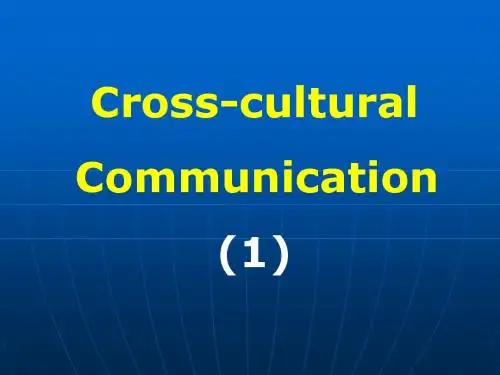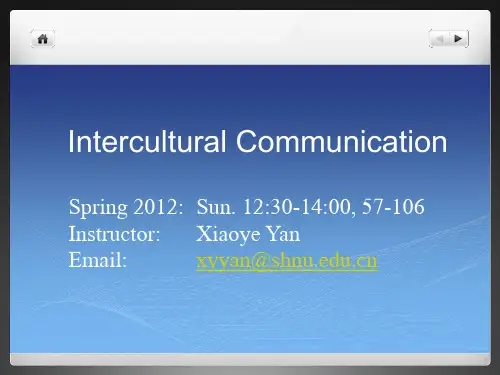跨文化交际课件Unit_I
- 格式:ppt
- 大小:2.92 MB
- 文档页数:22







Introduction to the Course▪1. Aim of the course: understand the cultural differences; communicate more effectively with people from other cultures▪2. Importance of the course:▪a. important for improving general cultural awareness▪b. can be applied in the training of business executive and technicians▪c. training of new immigrants and foreign students▪d. important in foreign language teaching and learning▪3. Way of learning: a. lecture; b. discussion;▪ c. research▪4. Assessment: 70% for final examination▪15% for PPT demonstration or research paper(>800 words)▪15% for class participation and attendance (AQs>3 times)▪5. Textbooks▪Language and Culture 刘润清邓炎昌外语教学与研究出版社▪Intercultural Communication 胡超编著外语教学与研究出版社▪《跨文化交际学概论》胡文仲著外语教学与研究出版社▪Intercultural Communication in Business 王维波,车丽娟主编外语教学与研究出版社Case Study 1▪In China:▪Xiao Li(an interpreter): Y ou must be very tired. Y ou’re old…▪Catherine(a n elderly American lady): Oh, I’m NOT old, and I’m NOT tired.▪In the West:▪A: How are you doing now? Would you like to rest?▪B: No, not a bit.Case Study 2▪In China, it is common to turn on the TV when visitors come to your home. Why?▪The intent is to be sure that your visitors are properly entertained.▪This is a case where the opposite is true in the United States.▪If a person or a family is watching the TV when visitors arrive, it is expected that the TV be turned off (or at least the sound turned dow n) immediately so that one’s full attention may be given to the visitors.Suggested topics for presentation▪1. Watch the movie 《刮痧》and list out the cultural conflicts and discuss them.▪2. What are the similarities and differences between Chinese and English table manners?▪3. What are the taboos related to Chinese Spring Festival and English Christmas?4. Find a copy of English menu and explain it to the class.▪5. Role-play a job interview with your partner.▪6. Compare English and Chinese humor.Unit One IC, Culture, Language and CommunicationUnit 1 Intercultural Communication1.1 Definition of intercultural communication▪It refers to the communication between different cultural backgrounds.▪a phenomenon (跨文化交际) –universal, long existed▪a discipline(跨文化交际学)--first started in the United States. 1959, Edward Hall ―The Silend Language‖ immigrants, foreign students and tourist multi-national and transnational companies1.2 Components of intercultural communication▪a. International communication:▪e.g. Japanese Prime Minister〈--〉American president (this is the communication between two nations)▪b. interracial communication: e.g. Afro American 〈--〉White American▪c. inter-ethnic communication e.g. Tibetan〈--〉Han (they are from different ethnic groups)▪d. inter-regional communication: e.g. A northerner 〈--〉A Southerner1.3 Reasons for the increased intercultural communication▪1. Mobile means of transport▪2. Easy and convenient communication channel▪3. Globalization of world economy.▪4. Mass migration.1.4 Three contributors to successful intercultural communication▪(1) the positive feeling we possess at the affective level, inc luding affirmation, self-esteem, comfort, trust, and safety;▪(2) the beliefs we bring into the intercultural encounter at the cognitive level, inc luding expectations, stereotypes, uncertainties, and misunderstanding of rules or procedures;▪(3) the actions or skills we possess at the behavioral level, including verbal and nonverbal communication skills in intercultural settings.Section 2. Culture2.1 The importance of adequate knowledge of culture▪1. it is necessary for the survival and existence of human beings as human beings.▪Evidence: (1) Wild boy of A veyon (2) wolf children of India▪Victor of Aveyron (also The Wild Boy of Aveyron) was a boy who apparently lived his entirechildhood naked and alone in the woods before being found wandering the woods in France in 1797. ▪wolf children, also known as wild children, are children who've grown up with minimal human contact, or even none at all. They may have been raised by animals (often wolves) or somehow survived on their own. In some cases, children are confined and denied normal social interaction with other people.3▪2. It is necessary in learning a foreign language. In a way, learning a foreign language is learning a foreign culture. It is significant to get the acquaintance with cultural differences and understanding target culture▪Examples: cases of misunderstandings between people from different culturesCase Study 3▪Here is a story of Litz, a Finnish and her Chinese husband.▪Here is the conversation:Litz: Dick, how long is your mum going to stay?Dick: I don’t know. I haven’t asked her.Litz: Why not ask her?Dick: What do you mean by asking her?Litz: I mean what I said. Just ask her how long she’s going to stay.▪Can you diagnose the problem in the communication?Case Study 4▪Jonathan: Ann, your English is improving.I’m pleased with your wor k.▪Ann: (Looking down) Oh, no. My Englishis not very good.▪J: Why do you say that, Ann? Y ou’redoing very well in class.▪A: No. I am not a good student.Continued:▪J: Ann, you’re making progress in this class.Y ou should be proud of your English.▪A: No, it’s not true. Y ou are a good teacher, butI am not a good student.▪Now predict Jonathan’s feeling.▪J: (He is surprised by her response and wonders why she thinks her English is so bad. He doesn’t know what to say and wonders if he should stop giving her compliments.)Continued:▪Question 1: Where do they come from?▪Question 2: Why did Jonathan feel like that?▪Question 3: If Ann is an American girl, what would she respond to Jonathan?Another conversation:▪Jonathan: Ann, your English is improving.I’m pleased with your work.▪Ann: (making eye contact) Thank you. I’ve learneda lot in this course.▪J: Y ou’re doing well and I can really see progress.▪A: I enjoy studying English. I do homework everynight.▪J: I can see that. Keep up the good work.▪A: I’ll try. Y ou are a good teacher. Y ou have helpedme a lot.▪Discussion: Did you ever experience misunderstanding in your communication with a foreigner? Or did you read anything about this? Please describe the situation and analyze the reason.2.2. Different interpretations of culture▪a.我没文化,不识字。



